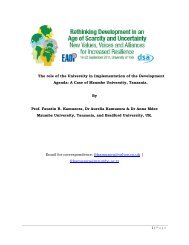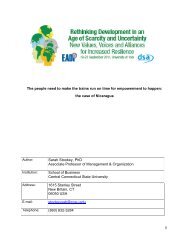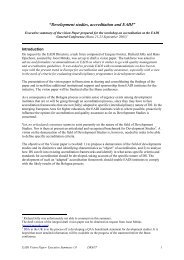Revenue Administration in Sub-Saharan Africa - International Tax ...
Revenue Administration in Sub-Saharan Africa - International Tax ...
Revenue Administration in Sub-Saharan Africa - International Tax ...
Create successful ePaper yourself
Turn your PDF publications into a flip-book with our unique Google optimized e-Paper software.
Executive summary<strong>Revenue</strong> adm<strong>in</strong>istration has, <strong>in</strong> the last two decades, become a focal area of fiscalreform <strong>in</strong> a number of <strong>Sub</strong>-<strong>Saharan</strong> <strong>Africa</strong>n (SSA) countries and various reforms arecurrently be<strong>in</strong>g undertaken to improve operational efficiency and modernize revenueadm<strong>in</strong>istration. This comparative <strong>in</strong>formation series reviews key aspects of revenueadm<strong>in</strong>istration <strong>in</strong> a sample of 15 SSA revenue bodies. 1 The follow<strong>in</strong>g is a summary ofeach of the chapters and its key f<strong>in</strong>d<strong>in</strong>gs.Chapter I reviews <strong>in</strong>stitutional arrangements put <strong>in</strong> place to conduct revenueadm<strong>in</strong>istration operations. The chapter observes that the majority of surveyedcountries’ <strong>in</strong>stitutional arrangements are based on the unified semi-autonomousrevenue body model. Under this model, revenue bodies <strong>in</strong>dicated that they hadsignificant powers to <strong>in</strong>terpret tax laws, allocate resources, design <strong>in</strong>ternal structuresand implement appropriate human resource management strategies, and wereresponsible for tax, customs, and non-tax revenue operations. It was also noted thatonly 3 countries have, to some extent, or are <strong>in</strong> the early stages of <strong>in</strong>tegrat<strong>in</strong>g thecollection of social security contributions with tax operations.Chapter II analyzes the organizational arrangements of revenue bodies. It is observedthat the majority of revenue bodies’ organizational structures are hybrid <strong>in</strong> nature,that is, they exhibit features attributable to two organizational models. In l<strong>in</strong>e withcurrent practice <strong>in</strong> tax adm<strong>in</strong>istration, a number of revenue bodies have set up aheadquarters function to provide operational policy guidance to field delivery. Thereview also notes that all revenue bodies (except Botswana) have set up a largetaxpayers’ office (LTO) to adm<strong>in</strong>ister all tax affairs of a small number of largeenterprises and <strong>in</strong>dividuals (<strong>in</strong> some countries).Chapter III provides <strong>in</strong>formation on practices commonly used by revenue bodies toprepare and publish bus<strong>in</strong>ess/strategic plans and performance reports. The chapternotes that all revenue bodies develop and dissem<strong>in</strong>ate 3 to 5-year bus<strong>in</strong>ess/corporateplans us<strong>in</strong>g established plann<strong>in</strong>g frameworks. A review of selected corporate/bus<strong>in</strong>essplans also <strong>in</strong>dicates that the mission statements, visions and objectives of revenuebodies are well articulated and a number of actions identified for each goal orobjective. It is also observed that strategic plann<strong>in</strong>g and performance managementsystems vary across revenue bodies—<strong>in</strong> terms of scope, content and application.Chapter IV exam<strong>in</strong>es <strong>in</strong>formation on resource allocation. It observes that themajority of revenue bodies are funded through parliamentary appropriations,mean<strong>in</strong>g that they develop budget proposals and bid for fund<strong>in</strong>g just like any othergovernment department/agency. Unique practices are noted: revenue bodies that aremandated to deduct and reta<strong>in</strong> a portion of revenue collection; and countries thatprovide their revenue body with a performance bonus (a percentage of thecollections). It is observed that cost of collection figures vary widely <strong>in</strong> the region (1-4%) while salary and related expenditures account for the largest portion (60-80%) ofthe budget. Also, <strong>in</strong> most of the surveyed countries, <strong>in</strong>vestment <strong>in</strong> <strong>in</strong>formationtechnology (IT) accounts for less than 2% of total adm<strong>in</strong>istrative expenditure.1Ben<strong>in</strong>, Ethiopia, Burundi, Botswana, Ghana, Kenya, Malawi, Mauritius, Rwanda, Senegal, Sierra Leone, South <strong>Africa</strong>,Tanzania, Uganda, and Zambia. The term revenue body is used <strong>in</strong> this document to comprise both <strong>in</strong>dependentrevenue adm<strong>in</strong>istration entities and those set up with<strong>in</strong> the m<strong>in</strong>istry of f<strong>in</strong>ance.6





